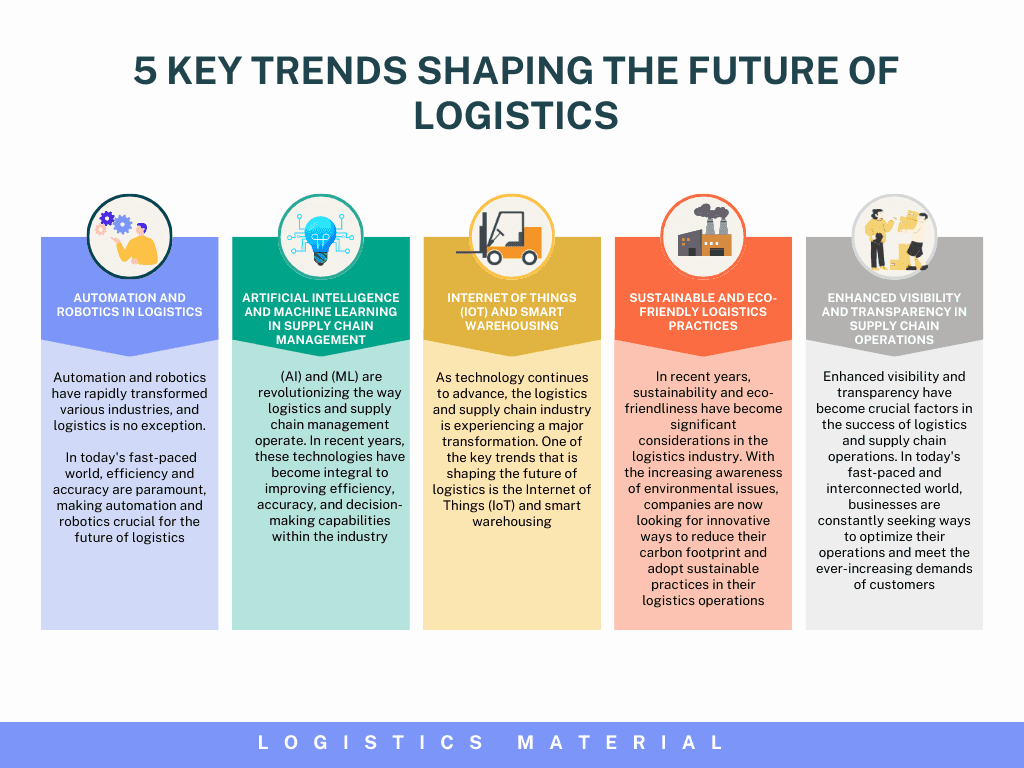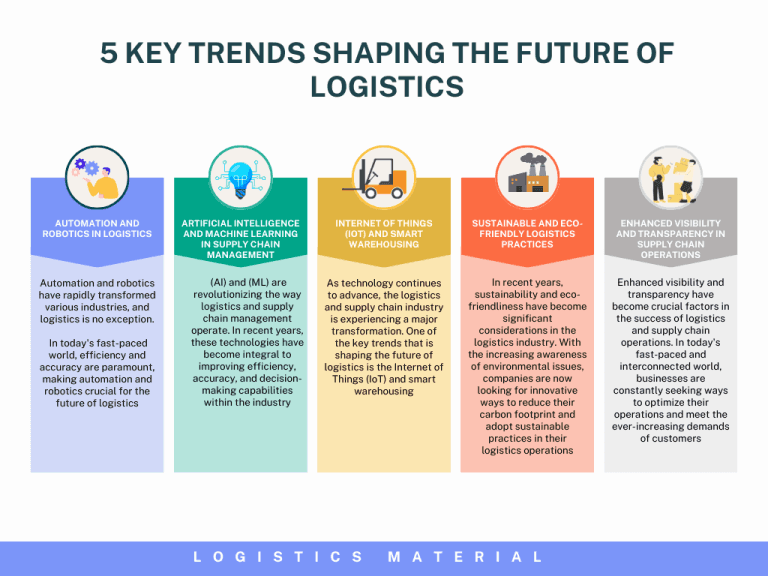By LM Team Writers – 7 November 2024
As the world becomes increasingly interconnected, the logistics industry stands at the forefront of this evolution, adapting to the dynamic needs of global trade and consumer expectations. From the rise of e-commerce to the growing demand for sustainability, the landscape of logistics is shifting in profound ways. With advancements in technology, changing consumer behaviors, and a heightened focus on efficiency and environmental responsibility, the industry is transforming remarkably.
In this blog post, we will explore five key trends that are shaping the fueling future success of logistics industry, providing insights into how businesses can innovate and thrive in this fast-paced environment. Join us on this journey as we delve into the exciting developments that promise to redefine the way goods are transported, tracked, and delivered in the years to come.
Table of Contents
1) The Impact of E-commerce on Logistics
Unquestionably, the growth of e-commerce has changed the logistical industry by altering the way that items are delivered, stored, and moved. As online shopping continues to surge, logistics providers are now faced with the challenge of meeting heightened consumer expectations for speed and efficiency. Customers increasingly demand rapid delivery options, often expecting their orders to arrive within a matter of hours or at most, the same day. This shift has necessitated the development of advanced warehousing solutions, with businesses investing in strategically located fulfillment centers to ensure quick dispatch and minimize transit times.
Moreover, the expansion of e-commerce has led to an explosion in order volume, which has compelled logistics providers to adopt innovative technologies. Automation, robotics, and artificial intelligence are becoming integral to sorting, packing, and managing inventory. Automated systems improve accuracy and enhance productivity, enabling warehouses to handle a higher throughput without compromising on service levels.
Additionally, the omnichannel retail environment has further complicated logistics operations. Companies must seamlessly integrate various sales channels—such as online marketplaces, brick-and-mortar stores, and direct-to-consumer platforms—to provide a cohesive experience. This requires a robust logistics strategy that can adapt to fluctuating demands while maintaining efficiency across all channels.
Sustainability is another critical aspect impacted by the e-commerce boom. As consumers become more environmentally conscious, logistics companies are exploring greener practices, such as optimizing delivery routes to reduce carbon footprints and using eco-friendly packaging materials. This focus on sustainability is not just a trend; it’s becoming a vital component of brand reputation and customer loyalty.
In summary, the impact of e-commerce on logistics is profound and multifaceted. As the industry continues to evolve, businesses that embrace these trends and adapt their operations accordingly will be well-positioned to thrive in tomorrow’s competitive landscape. The synergy between technology, consumer demands, and sustainability will shape the logistics industry for years to come, creating opportunities for innovation and growth.
2) Advancements in Technology and Automation
Advancements in technology and automation are at the forefront of transforming the logistics industry, ushering in a new era of efficiency and precision. As businesses strive to meet the demands of an increasingly fast-paced marketplace, the integration of cutting-edge technologies is proving essential. From the implementation of artificial intelligence (AI) to the rise of robotics and autonomous vehicles, these innovations are reshaping how goods are transported, tracked, and delivered.
One significant advancement is the use of AI and machine learning algorithms to optimize supply chain operations. These technologies analyze vast amounts of data to predict demand, streamline inventory management, and enhance route planning. By doing so, they not only reduce operational costs but also minimize delivery times, ensuring that customers receive their orders promptly.
Automation is another key player in this transformation. Automated warehouses equipped with advanced robotics systems are revolutionizing how products are stored and retrieved. These robots can efficiently navigate complex warehouse layouts, picking and packing items at speeds far surpassing human capabilities. This increased efficiency not only boosts productivity but also allows companies to allocate human resources to more strategic tasks, fostering innovation and creativity.
Moreover, the adoption of the Internet of Things (IoT) is enhancing real-time visibility across the supply chain. Smart sensors and connected devices track shipments in transit, providing up-to-date information on location and condition. This level of transparency not only improves operational decision-making but also fosters trust and communication between logistics providers and their customers.
As these technological advancements continue to evolve, they are poised to redefine the logistics landscape. Companies that embrace these innovations will not only streamline their operations but also enhance customer satisfaction and gain a competitive edge in the marketplace. The future success of logistics is bright, and technology is the key to unlocking its full potential.
3) The Shift Towards Sustainable Practices
s the world grapples with climate change and environmental degradation, the logistics industry is undergoing a significant transformation driven by a shift towards sustainable practices. This trend is not just a response to regulatory pressures; it reflects a profound change in consumer expectations and corporate responsibility. Today’s consumers are more environmentally conscious than ever, favoring companies that demonstrate a commitment to sustainability. As a result, logistics providers are adopting greener practices that reduce their carbon footprints and enhance operational efficiency.
One of the prominent shifts is the increased use of electric vehicles (EVs) in delivery fleets. With advancements in battery technology and growing infrastructure for charging stations, logistics companies are investing in EVs to minimize emissions and lower fuel costs. This transition not only helps in meeting sustainability goals but also positions companies favorably in a market that increasingly values eco-friendly practices.
Moreover, the logistics sector is embracing innovative packaging solutions that reduce waste. For instance, companies are exploring biodegradable materials and optimizing packaging sizes to minimize excess. This not only lessens the environmental impact but also cuts costs associated with shipping and storage. Additionally, the move towards circular economy principles is gaining traction. This approach encourages the reuse and recycling of materials, thus extending the lifecycle of products and reducing the demand for new resources.
Another critical aspect of this sustainability trend is the integration of technology. Data analytics and artificial intelligence are being leveraged to optimize supply chain routes, improving efficiency and reducing fuel consumption. By utilizing predictive modeling, logistics companies can streamline operations, anticipate demand fluctuations, and make better-informed decisions that align with sustainability goals.
In conclusion, the shift towards sustainable practices is reshaping the logistics business, making it more responsive to the needs of consumers and the environment. As companies continue to innovate and implement eco-friendly solutions, the logistics landscape will not only become greener but also more resilient and competitive in the years to come. Embracing sustainability is no longer just an option; it is an essential pathway for future growth in the logistics sector.
4) The Rise of Last-Mile Delivery Solutions
As e-commerce continues to flourish, one of the most significant trends reshaping the logistics industry is the rise of last-mile delivery solutions. This critical segment of the supply chain refers to the final step in the delivery process, where goods are transported from a distribution center to the end customer’s doorstep. With consumer expectations evolving, the demand for faster, more efficient last-mile delivery options is at an all-time high.
Companies are increasingly adopting innovative strategies to tackle the challenges associated with last-mile logistics, such as traffic congestion, rising fuel costs, and the need for real-time tracking. The implementation of technology is paramount in this transformation. Delivery services are now leveraging advanced routing and scheduling software powered by artificial intelligence to optimize delivery routes, thus reducing transit times and costs.
Moreover, the integration of drones and autonomous vehicles is starting to gain traction, promising to revolutionize how goods are delivered. These technologies can navigate through urban landscapes with ease, bypassing traditional traffic bottlenecks and enhancing delivery speed. Additionally, partnerships with local businesses and the use of micro-fulfillment centers are emerging as effective strategies to streamline the last-mile process, allowing for quicker access to products and minimizing delivery distances.
Sustainability is also becoming a focal point in last-mile delivery. Consumers are becoming increasingly environmentally conscious, leading logistics companies to explore eco-friendly delivery options. This includes utilizing electric vehicles, cycling couriers, and even pedestrian delivery methods in urban areas, all aimed at reducing carbon footprints and promoting greener logistics practices.
In conclusion, the rise of last-mile delivery solutions is not just a trend but a necessary evolution within the logistics business. As companies adapt to the growing expectations of consumers and the challenges posed by urbanization, the focus on efficiency, technology, and sustainability will continue to shape the future of how goods reach our doorsteps.
5) The Importance of Data Analytics in the Logistics Industry
In the rapidly evolving logistics industry, data analytics has emerged as a cornerstone for driving efficiency, improving decision-making, and enhancing customer satisfaction. As businesses strive to stay competitive in a landscape marked by globalization and rising consumer expectations, leveraging data analytics transforms vast amounts of information into actionable insights.
One of the primary advantages of data analytics in logistics is its ability to optimize supply chain operations. By analyzing historical data, companies can identify patterns in demand, enabling them to forecast needs more accurately and adjust their inventory levels accordingly. This not only reduces the risk of overstocking or stockouts but also minimizes holding costs, ultimately leading to improved cash flow.
Additionally, real-time data analytics offers unprecedented visibility into logistics operations. Companies can track shipments, monitor transportation routes, and assess performance metrics in real-time, allowing them to make informed decisions promptly. For instance, if a delay arises due to unforeseen circumstances, data analytics can help logistics managers reroute shipments or communicate proactively with customers, enhancing transparency and trust.
Furthermore, predictive analytics, a subset of data analytics, empowers logistics providers to anticipate future challenges and opportunities. By analyzing trends and historical data, businesses can identify potential disruptions—such as supply chain interruptions or changes in customer demand—and implement strategies to mitigate risks. This foresight not only strengthens resilience but also fosters a culture of continuous improvement within the organization.
In essence, the importance of data analytics in logistics cannot be overstated. It serves as a powerful tool that not only streamlines operations and cuts costs but also enhances service quality and customer satisfaction. As technology continues to advance, companies that harness the power of data analytics will be better equipped to navigate the complexities of the logistics landscape and thrive in a competitive marketplace. Embracing this trend is not just an option; it’s a necessity for those looking to shape the future of the logistics business.
Unlock Massive Savings with Hostinger’s Happy Friday Deals
Whether you’re starting a new website or upgrading an existing one, Hostinger’s Black Friday offers give you the best prices of the year on reliable, high-speed hosting solutions. Don’t miss out on this limited-time chance to enhance your online presence for less. Grab your deal before it’s gone!

The Bottom Line
The logistics industry is on a transformative journey propelled by the rapid rise of e-commerce. As we’ve explored, the demands of online shopping have reshaped how businesses approach delivery, warehousing, and inventory management. With customer expectations at an all-time high for speed and efficiency, logistics providers are compelled to adapt by investing in advanced technologies that streamline operations and enhance service delivery. Embracing automation, robotics, and AI not only meets the immediate needs of the market but also positions companies for sustainable growth in a competitive landscape.
As these trends continue to evolve, staying ahead of the curve will be crucial for anyone involved in logistics. We encourage you to keep an eye on these developments, as they hold the key to unlocking new opportunities in the future of the industry. Thank you for joining us in exploring these pivotal shifts—together, let’s navigate the exciting future success of logistics!
Frequency Ask Questions
How is e-commerce reshaping the logistics industry?
E-commerce has dramatically increased demand for faster, more efficient delivery. This has led to a surge in last-mile delivery solutions, the rise of fulfillment centers, and the adoption of advanced technologies like AI and robotics to streamline operations.
What is the impact of technology on the future success of logistics?
Technology is revolutionizing the logistics business. AI and machine learning are optimizing routes, predicting demand, and improving inventory management. Automation and robotics are increasing efficiency in warehouses and distribution centers. IoT devices enable real-time tracking of shipments, enhancing visibility and responsiveness.
Why is sustainability becoming increasingly important in the logistics industry?
Consumers are demanding more sustainable practices, and regulatory pressures are mounting. Logistics companies are adopting eco-friendly solutions like electric vehicles, sustainable packaging, and optimized routing to reduce their carbon footprint.
How can businesses leverage data analytics to improve their logistics operations?
Data analytics provides valuable insights into supply chain performance. By analyzing data, businesses can identify bottlenecks, optimize inventory levels, and make data-driven decisions to improve efficiency and reduce costs.
What are the key challenges and opportunities in the last-mile delivery segment?
Last-mile delivery is a complex and costly aspect of logistics. Challenges include traffic congestion, rising fuel costs, and the need for timely and accurate deliveries. Opportunities lie in innovative solutions like drone delivery, micro-fulfillment centers, and alternative delivery methods to improve efficiency and customer satisfaction.










